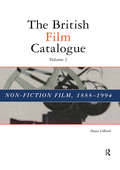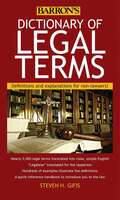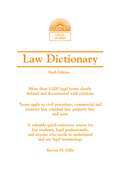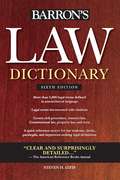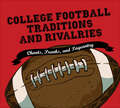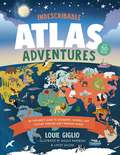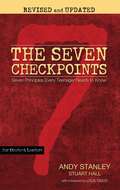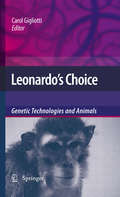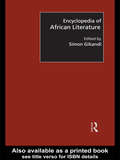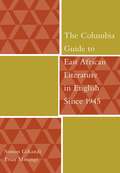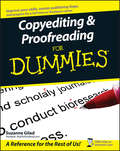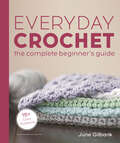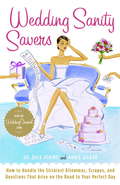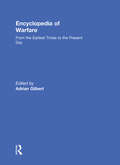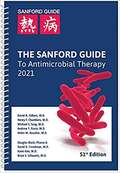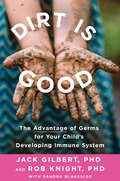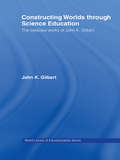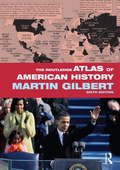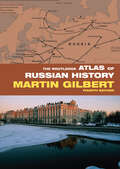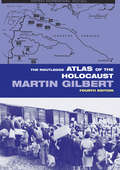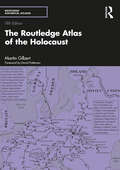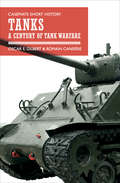- Table View
- List View
The British Film Catalogue: The Non-Fiction Film
by Denis GiffordFirst published in 2001. The standard work on its subject, this resource includes every traceable British entertainment film from the inception of the "silent cinema" to 1994. Now, this new edition includes a wholly original second volume devoted to non-fiction and documentary film--an area in which the British film industry has particularly excelled. All entries throughout this third edition have been revised, and coverage has been extended through 1994.Together, these two volumes provide a unique, authoritative source of information for historians, archivists, librarians, and film scholars.
Dictionary of Legal Terms: Definitions and Explanations for Non-Lawyers
by Stephen H. GifisUpdated to include new terms and to incorporate recent changes in laws and judicial interpretations, this handy dictionary:Contains over 2500 legal terms defined in clear, easy to understand EnglishTranslates “legalese” for the laypersonIncludes hundreds of examples to illustrate the definitionsIs an ideal book for quick reference or to learn more about the law:Non-lawyers will appreciate the way this book cuts through the complexities of legal jargon and presents definitions and explanations that are easily understood and referenced. The terms are arranged alphabetically and given with definitions and explanations for consumers, business proprietors, legal beneficiaries, investors, property owners, litigants, and all others who have dealings with the law. Find definitions on everything from Abandonment and Abatable Nuisance, all the way through to Zoning.
Law Dictionary, (Mass Market) 6th Ed.: Mass Market Edition
by Steven H. GifisA Simon & Schuster eBook. Simon & Schuster has a great book for every reader.
Law Dictionary, (Trade) 6th Ed: Mass Market Edition
by Steven H. GifisA Simon & Schuster eBook. Simon & Schuster has a great book for every reader.
College Football Traditions and Rivalries: Chants, Pranks, and Pageantry
by Morrow GiftA must-have for football fans of all ages, this handsomely designed gift book is a comprehensive illustrated guide to the greatest traditions and rivalries in college football.Every Saturday each fall, millions of Americans watch their favorite college teams take to the gridiron, battling to make it to the coveted national championship bowl game in January. From the Cornhuskers of the University of Nebraska to the Nittany Lions of Penn State, the USC Trojans to Alabama’s Crimson Tide, the University of Michigan Wolverines to the Clemson Tigers, each school has its own traditions, trivia, and rivalries.This concise, illustrated handbook is a collection of the past and present lore of college football’s major teams for both novices and diehard followers alike. Focusing on the top schools from each division, this handy guide contains original full-color illustrations that showcase the biggest traditions and rivalries in the sport, along with a short description and fun trivia. Learn about the pink visitor’s locker room at Iowa State, the prisoner exchange preceding the annual Army–Navy showdown, and the University of Miami team’s dramatic smoke-filled stadium entrance. The book also includes a special section of quick facts on some other schools that weren’t fully featured.Fascinating and informative, filled with seventy full-color illustrations, College Football Traditions and Rivalries is a must for every college football fan.
Indescribable Atlas Adventures: An Explorer's Guide to Geography, Animals, and Cultures Through God's Amazing World (Indescribable Kids)
by Louie GiglioWith more than 50 infographic maps, this illustrated world atlas for kids from bestselling author Louie Giglio will stretch your children's understanding of the world as they discover more about God, science, and His amazing world!Indescribable Atlas Adventures offers a self-guided tour for your favorite explorer throughout the seven continents and over 50 countries. Easy-to-read maps, more than 1,500 facts, and a world map that helps kids identify each continent and country will help your child to think globally and discover new insights into God's incredible creation. Each map includesan overview of each country's population, languages, and prominent features;key facts about the country's capital cities; neighboring countries; and the national bird, tree, and dish;notable people and their amazing achievements;the country's terrain, climate, wildlife, contributions to space exploration, cultural hallmarks, and Christian faith traditions; andbiblical and inspirational pieces, like devotional thoughts, prayers, and Bible verses that highlight how amazing God and His world are.Indescribable Atlas Adventures is for ages 6 to 10 and spotlights several fascinating ecosystems, like the Sahara, Amazon, and Great Barrier Reef. This book has a large trim size to help kids explore fun details on each page and is a perfect "my first atlas of the world" gift for curious kids.Check out these other books from Pastor Louie's Indescribable Kids series, which has sold more than a million copies:IndescribableHow Great Is Our GodThe Wonder of CreationIndescribable for Little OnesIndescribable Activity Book for Kids
The Seven Checkpoints for Student Leaders
by Louie Giglio Stuart Hall Andy StanleyThe Seven Checkpoints for Student Leaders is more than a book; it is a ministry plan. It goes far beyond the "how to" of youth ministry and provides youth ministers, youth works, and parents with the content that students need to equip them for 'life beyond youth group." The material in this book and the companion book The Seven Checkpoints Student Journal reveals what Stanley calls "the irreducible minimum"--the essential principles upon which an entire youth ministry can be built. Stanley and Hall offer some unorthodox but very sensible approaches to planning and maintaining a youth group over a long period of time with a specific goal in mind. The book outlines a strategy for effectively teaching students over the course of their time in school, and this new updated edition is what every leader needs to keep up with the ever-changing challenges students face. Stanley and Hall identify seven "checkpoints" that are the most important and critical issues facing teens: 1. Authentic Faith 2. Spiritual Disciplines 3. Moral Boundaries (this section deals primarily with issues of sexual purity and dating) 4. Healthy Friendships 5. Wise Choices 6. Ultimate Authority 7. Others FirstPractical application, biblical principles, and realistic approaches for facing modern challenges facilitate teaching for busy youth leaders that will make an impact for eternity.
The Seven Checkpoints for Student Leaders: Seven Principles Every Teenager Needs to Know
by Louie Giglio Stuart Hall Andy StanleyThe Seven Checkpoints for Student Leaders is more than a book; it is a ministry plan. It goes far beyond the "how to" of youth ministry and provides youth ministers, youth works, and parents with the content that students need to equip them for 'life beyond youth group." The material in this book and the companion book The Seven Checkpoints Student Journal reveals what Stanley calls "the irreducible minimum"--the essential principles upon which an entire youth ministry can be built. Stanley and Hall offer some unorthodox but very sensible approaches to planning and maintaining a youth group over a long period of time with a specific goal in mind. The book outlines a strategy for effectively teaching students over the course of their time in school, and this new updated edition is what every leader needs to keep up with the ever-changing challenges students face. Stanley and Hall identify seven "checkpoints" that are the most important and critical issues facing teens: 1. Authentic Faith 2. Spiritual Disciplines 3. Moral Boundaries (this section deals primarily with issues of sexual purity and dating) 4. Healthy Friendships 5. Wise Choices 6. Ultimate Authority 7. Others FirstPractical application, biblical principles, and realistic approaches for facing modern challenges facilitate teaching for busy youth leaders that will make an impact for eternity.
Leonardo’s Choice
by Carol GigliottiLeonardo's Choice: Genetic Technologies and Animals is an edited collection of twelve essays and one dialogue focusing on the profound affect the use of animals in biotechnology is having on both humans and other species. Communicating crucial understandings of the integrated nature of the human and non-human world, these essays, unlike the majority of discussions of biotechnology, take seriously the impact of these technologies on animals themselves. This collection's central questions revolve around the disassociation Western ideas of creative freedom have from the impacts those ideas and practices have on the non-human world. This transdisciplinary collection includes perspectives from the disciplines of philosophy, cultural theory, art and literary theory, history and theory of science, environmental studies, law, landscape architecture, history, and geography. Included authors span three continents and four countries. Included essays contribute significantly to a growing scholarship surrounding "the question of the animal" emanating from philosophical, cultural and activist discourses. Its authors are at the forefront of the growing number of theorists and practitioners across the disciplines concerned with the impact of new technologies on the more-than-human world.
Encyclopedia of African Literature
by Simon GikandiThe most comprehensive reference work on African literature to date, this book covers all the key historical and cultural issues in the field. The Encyclopedia contains over 600 entries covering criticism and theory, African literature's development as a field of scholarship, and studies of established and lesser-known writers and their texts. While the greatest proportion of literary work in Africa has been a product of the twentieth century, the Encyclopedia also covers the literature back to the earliest eras of story-telling and oral transmission, making this a unique and valuable resource for those studying social sciences as well as humanities. This work includes cross-references, suggestions for further reading, and a comprehensive index.
The Columbia Guide to East African Literature in English Since 1945 (The Columbia Guides to Literature Since 1945)
by Simon Gikandi Evan MwangiThe Columbia Guide to East African Literature in English Since 1945 challenges the conventional belief that the English-language literary traditions of East Africa are restricted to the former British colonies of Kenya, Uganda, and Tanzania. Instead, these traditions stretch far into such neighboring countries as Somalia and Ethiopia.Simon Gikandi and Evan Mwangi assemble a truly inclusive list of major writers and trends. They begin with a chronology of key historical events and an overview of the emergence and transformation of literary culture in the region. Then they provide an alphabetical list of major writers and brief descriptions of their concerns and achievements. Some of the writers discussed include the Kenyan novelists Grace Ogot and Ngugi wa Thiong'o, Ugandan poet and essayist Taban Lo Liyong, Ethiopian playwright and poet Tsegaye Gabre-Medhin, Tanzanian novelist and diplomat Peter Palangyo, Ethiopian novelist Berhane Mariam Sahle-Sellassie, and the novelist M. G. Vassanji, who portrays the Indian diaspora in Africa, Europe, and North America. Separate entries within this list describe thematic concerns, such as colonialism, decolonization, the black aesthetic, and the language question; the growth of genres like autobiography and popular literature; important movements like cultural nationalism and feminism; and the impact of major forces such as AIDS/HIV, Christian missions, and urbanization. Comprehensive and richly detailed, this guide offers a fresh perspective on the role of East Africa in the development of African and world literature in English and a new understanding of the historical, cultural, and geopolitical boundaries of the region.
Copyediting and Proofreading For Dummies
by Suzanne GiladTurn your knack for language into a lucrative careerMust-know techniques and resources for maximizing your accuracy and speedInterested in becoming a copyeditor or proofreader? Want to know more about what each job entails? This friendly guide helps you position yourself for success. Polish your skills, build a winning résumé and land the job you've always wanted. Books, magazines, Web sites, corporate documents - find out how to improve any type of publication and make yourself indispensable to writers, editors, and your boss.Balance between style and rulesMaster the art of the queryUse proofreader symbolsEdit and proof electronic documentsBuild a solid freelancing career
Everyday Crochet: 15+ Cozy Patterns
by June GilbankLearning crochet has never been easier!You&’ve seen gorgeous crochet items online and in boutique shops, and you&’d love to learn to create them yourself. Now&’s your chance! Packed with hundreds of inspirational color photos and easy-to-follow instructions, this fun guide teaches you how to hook your way to a wonderful new skill. This revised edition includes:Expert advice on choosing your hook, yarn, and other helpful toolsStitch-by-stitch lessons for dozens of pretty and practical stitchesIllustrated instructions for shaping your work with increases and decreasesGuidance on reading crochet patterns and decoding crochet chartsTroubleshooting tips for avoiding common crochet mistakesMore than 15 stylish projects and patterns that build on what you&’ve learned
Wedding Sanity Savers: How to Handle the Stickiest Dilemmas, Scrapes, and Questions That Arise on the Road to Your Perfect Day
by Annie Gilbar Dale AtkinsAs a bride, you worry about finding the perfect dress, choosing the location for the reception, and keeping your wedding expenses within a certain budget. But beyond the straight ABCs of planning a wedding lie the more personal, emotional issues that can threaten to unravel your perfect day: jealous friends, bratty bridesmaids, complicated extended families, and pre-wedding jitters. Thankfully, help is here! From wedding and relationship experts Dr. Dale Atkins and Annie Gilbar comesWedding Sanity Savers--the ultimate troubleshooting guide for the sticky situations that arise on the road to happily ever after. From the day you get engaged until the day you say "I do,"Wedding Sanity Saversprovides fresh, frank advice that you won't find in other wedding books. With over 300 Q&As from real brides that tackle issues including body image, friends and exes, divorced parents, in-laws, merging religions and cultures, money questions, planning mishaps, sticking up for yourself, and more,Wedding Sanity Saversgives you the strategies you need to make tough decisions, finesse difficult scenarios, stay true to yourself, and keep smiling throughout it all. From the Trade Paperback edition.
Men’s Private Parts
by James H. GilbaughNever has the subject of men's health attracted more attention than in this era of optimal living. In this revised and updated edition of Men's Private Parts: A Pocket Reference to Prostate, Urologic, and Sexual Health, the author-known for years to readers of the Men's Health newsletter as "Dr. Private Parts"-tackles men's most delicate health questions with reassuring authority.
Encyclopedia of Warfare: From the Earliest Times to the Present Day
by Adrian GilbertThe Encyclopedia of Warfare is a chronological account of the development of warfare since the beginnings of recorded history. The book is organized in 10 chapters, each of which looks at a particular era in warfare from the ancient world to the present. Each chapter includes color maps of key campaigns, as well as commentary on battles, personalities, troops, and equipment. Sidebars throughout the main narrative focus on noteworthy aspects of the history of conflict. Through its chronological organization and ample use of maps, the Encyclopedia also clearly conveys the link between war and world geographical history. A thorough yet concise exploration of combat throughout human history, this fascinating and informative reference work is an outstanding addition to any library collection.
The Sanford Guide to Antimicrobial Therapy 2021
by David N. Gilbert M. D. Henry F. Chambers Michael S. Saag Andrew T. Pavia Helen W. BoucherThe 51st edition of the leading clinical reference on treatment of infectious diseases and anti-infective drug information. Helpful in day-to-day practice and as a component of your organization's antimicrobial stewardship program, The Sanford Guide provides valuable guidance in the age of antibiotic resistance. <p><p>Popular with physicians, pharmacists, physician assistants, nurse practitioners, and other clinicians, The Sanford Guide to Antimicrobial Therapy provides information that is convenient, concise, and reliable. <p><p>Coverage includes: Clinical syndromes, pathogens (bacterial, fungal, mycobacterial, parasitic, viral), anti-infective agents, dosing with pediatric and renal adjustments, adverse affects, spectra of activity, pharmacology, drug-drug interactions, and preventative therapy.
The Sanford Guide to Antimicrobial Therapy
by David N. Gilbert Jay P. Sanford Michael S. Saag M. D.This leading clinical is reference on treatment of infectious diseases and anti-infective drug information. Helpful in day-to-day practice and as a component of your organization's antimicrobial stewardship program, the Sanford Guide provides valuable guidance in the age of antibiotic resistance. Popular with physicians, pharmacists, physician assistants, nurse practitioners, and other clinicians, the Sanford Guide to Antimicrobial Therapy provides information that is convenient, concise, and reliable.
Dirt Is Good: The Advantage of Germs for Your Child's Developing Immune System
by Jack Gilbert Rob KnightFrom two of the world’s top scientists and one of the world’s top science writers (all parents), Dirt Is Good is a q&a-based guide to everything you need to know about kids & germs.“Is it OK for my child to eat dirt?” That’s just one of the many questions authors Jack Gilbert and Rob Knight are bombarded with every week from parents all over the world. They've heard everything from “My two-year-old gets constant ear infections. Should I give her antibiotics? Or probiotics?” to “I heard that my son’s asthma was caused by a lack of microbial exposure. Is this true, and if so what can I do about it now?” Google these questions, and you’ll be overwhelmed with answers. The internet is rife with speculation and misinformation about the risks and benefits of what most parents think of as simply germs, but which scientists now call the microbiome: the combined activity of all the tiny organisms inside our bodies and the surrounding environment that have an enormous impact on our health and well-being. Who better to turn to for answers than Drs. Gilbert and Knight, two of the top scientists leading the investigation into the microbiome—an investigation that is producing fascinating discoveries and bringing answers to parents who want to do the best for their young children. Dirt Is Good is a comprehensive, authoritative, accessible guide you've been searching for.
Constructing Worlds through Science Education: The Selected Works of John K. Gilbert
by John K. GilbertInternationally renowned and award-winning author John Gilbert has spent the last thirty years researching, thinking and writing about some of the central and enduring issues in science education. He has contributed over twenty books and 400 articles to the field and is Editor-in-Chief of the International Journal of Science Education. For the first time he brings together sixteen of his key writings in one volume. This unique book highlights important shifts in emphasis in science education research, the influence of important individuals and matters of national and international concern. All this is interwoven in the following four themes: explanation, models and modeling in science education relating science education and technology education informal education in science and technology alternative conceptions and science education.
The Routledge Atlas of American History: From The First Exploration To The Present Day (Routledge Historical Atlases)
by Martin GilbertThe Routledge Atlas of American History presents a series of 163 clear and detailed maps, accompanied by informative captions, facts and figures. The complete history of America is unravelled through vivid representations of all the significant landmarks, including: Politics – from the struggle against slavery and the battle for black voting rights to the present day, including the results of the 2008 Presidential election Military Events – from the War of Independence to the conflicts in Korea, Vietnam and the Gulf, including additional new maps covering the war in Iraq and the American campaign in Afghanistan. Social History – including the fate of the American Indians, the growth of female emancipation, and recent population movements and immigration Transport – from nineteenth-century railroads and canals to the growth of air travel and recent ventures into space Economics – from early farming and industry to urbanisation and the ecological struggles of the present day This revised edition is fully updated to cover the 2008 presidential election, and also addresses President Obama’s healthcare policy and first overseas travels. New maps have been drawn which detail the problem of pollution, as well as the most recent developments in US relations with Iran, Iraq and Afghanistan.
The Routledge Atlas of Russian History (Routledge Historical Atlases)
by Martin GilbertThe complex and often turbulent history of Russia over the course of 2,000 years is brought to life in a series of 176 maps by one of the most prolific and successful historian authors today. This fourth edition of The Routledge Atlas of Russian History covers not only the wars and expansion of Russia but also a wealth of less conspicuous details of its history, from famine and anarchism to the growth of naval strength and the strengths of the river systems. From 800 BC to the fall of the Soviet Union, this indispensable guide to Russian history covers: war and conflict: from the triumph of the Goths between 200 and 400 BC to the defeat of Germany at the end of the Second World War and the end of the Cold War politics: from the rise of Moscow in the Middle Ages to revolution, the fall of the monarchy and the collapse of communism industry, economics and transport: from the Trans-Siberian Railway between 1891 and 1917 to the Virgin Lands Campaign and the growth of heavy industry society, trade and culture: from the growth of monasticism to peasant discontent, Labour Camps and the geographical distribution of ethnic Russians. Now bringing new material to view, and including seven new maps, this popular atlas will more than readily gain a place on the bookshelves of anyone interested in the history of Russia.
The Routledge Atlas of the Holocaust: The Complete History (Routledge Historical Atlases)
by Martin GilbertThe graphic history of the Nazi attempt to destroy the Jews of Europe during the Second World War is illustrated in this series of 333 detailed maps. The maps, and the text and photographs that accompany them, powerfully depict the fate of the Jews between 1933 and 1945, while also setting the chronological story in the wider context of the war itself. The maps include: historical background – from the effects of anti-Jewish violence between 1880 and 1933 to the geography of the existing Jewish communities before the advent of the Nazis the beginning of the violence – from the destruction of the synagogues in November 1938 to Jewish migrations and deportations, the ghettos, and the establishment of the concentration camps and death camps throughout German-dominated Europe the spread of Nazi rule – the fate of the Jews throughout Europe including Germany, Austria, Poland, Greece, Yugoslavia, Bulgaria, Russia, Denmark, Norway, France, Holland, Belgium, Italy, and the Baltic States Jewish revolts and resistance – acts of armed resistance, fighting in the forests, individual acts of courage Jews in hiding – escape routes, Christians who helped Jews the death marches – the advance of the Allies and the liberation of the camps, the survivors, and the final death toll. This revised edition includes a new section which gives an insight into the layout and organization of some of the most significant places of the Holocaust, including Auschwitz, Treblinka and the Warsaw ghetto, maps that will be especially useful to those visiting the sites.
The Routledge Atlas of the Holocaust (Routledge Historical Atlases)
by Martin GilbertThe graphic history of the Nazi attempt to destroy the Jews of Europe during the Second World War is illustrated in this series of 363 detailed maps. The maps, and the text and photographs that accompany them, powerfully depict the fate of the Jews between 1933 and 1945, while also setting the chronological story in the wider context of the war itself. The maps include: • Historical background – from the effects of anti-Jewish violence between 1880 and 1933 to the geography of the existing Jewish communities when the Nazi Party came to power • The beginning of the violence – from the destruction of the synagogues in November 1938 to Jewish migrations and deportations, the ghettos, and the establishment of the concentration camps and death camps throughout German-dominated Europe • The spread of Nazi rule – the fate of the Jews throughout Europe including Germany, Austria, Poland, Greece, Yugoslavia, Bulgaria, Russia, Denmark, Norway, France, Holland, Belgium, Italy, and the Baltic States • Jewish revolts and resistance – acts of armed resistance, fighting in the forests, individual acts of courage • Jews in hiding – escape routes, Christians who helped Jews • The death marches – the advance of the Allies and the liberation of the camps, the survivors, and the final death toll. This new edition now includes an additional 30 of Martin Gilbert’s maps, with many additional camp and ghetto maps, further illustrating the layout and organization of some of the most significant towns and cities affected by the Holocaust, especially useful to those visiting the sites.
Tanks: A Century of Tank Warfare (Casemate Short History)
by Oscar E. Gilbert Romain Cansiere&“For all the history buffs on warfare of the last century, Tanks is a perfect choice . . . packed with fascinating information&” (San Francisco Book Review). This Casemate Short History—by the authors of Tanks in Hell: A Marine Corps Tank Company on Tarawa—provides an informative and entertaining introduction to this iconic weapon of the last hundred years. Tanks first ventured into battle on the Somme in 1916, and by the end of the war, countries were beginning to choose &“heavy&” or &“light&” tank designs to suit their preferred doctrine. Design then stagnated until World War II brought about rapid change. Tanks would prove integral to fighting in almost every theater; the Germans swept across Europe using tanks to spearhead their blitzkrieg method of war, until Soviet tanks proved more than their match and led to some epic tank battles on a huge scale. After World War II, tank designs became increasingly sophisticated and armor undertook a variety of roles in conflicts, with mixed results. American armor in Korea was soon forced into an infantry support role, which it reprised in Vietnam, while Soviet armor was defeated in guerrilla warfare in Afghanistan. However, tanks played a pivotal role in the American &“shock and awe&” doctrine in two wars in Iraq, and tanks remain a crucial weapons system on the battlefield. &“Comprehensive despite its conciseness. For example, it addresses the employment of tanks in lesser-known conflicts such as the Indio-Pakistani and Sino-Vietnamese wars. The book provides context for contemporary tank operations and offers a perspective on the way ahead.&” —Military Review
